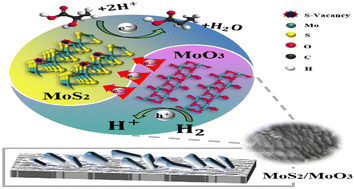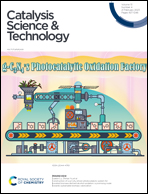Sustainable production of bio-propionic acid: synergy between vacancy and thermoelectron in MoS2/MoO3 composite-enhanced hydrodeoxygenation of lactic acid†
Abstract
Hydroxyl-specific site hydrodeoxygenation is the key to improving the performance of catalysts in the selective conversion of lactic acid (LA) to propionic acid (PA). Construction of a composite structure and surface defects are considered to be an effective way to increase the catalytic activity. In this study, a MoS2/MoO3 composite with compact intersecting phases and sulfur vacancies was prepared by hydrothermal synthesis and oxidative desulfurization. The optoelectronic properties of the materials were successfully used to correlate with their hydrodeoxygenation (HDO) thermocatalytic activities, and then an electron transfer process was proposed to understand the HDO pathway. The composite structure of the MoS2/MoO3 catalyst promoted the formation of sulfur vacancies, leading to a narrow band gap and decreased charge transfer resistance, which facilitated the transfer of electrons. Meanwhile, the transferred electrons can be easily trapped by sulfur vacancies, and then these trapped electrons immediately take part in the reduction of LA to PA. Thus, the electron recombination was suppressed and the HDO catalytic activity was improved. Due to the synergy, the MoS2/MoO3 composite offered superior conversion (90.4%) of LA and selectivity (88.4%) toward PA compared to other molybdenum-based catalysts such as MoO3, MoS2, and MoS2–MoO3 (mechanical mixture) in the LA hydrodeoxygenation (HDO) reaction, and the activity hardly decayed after running for five cycles.



 Please wait while we load your content...
Please wait while we load your content...